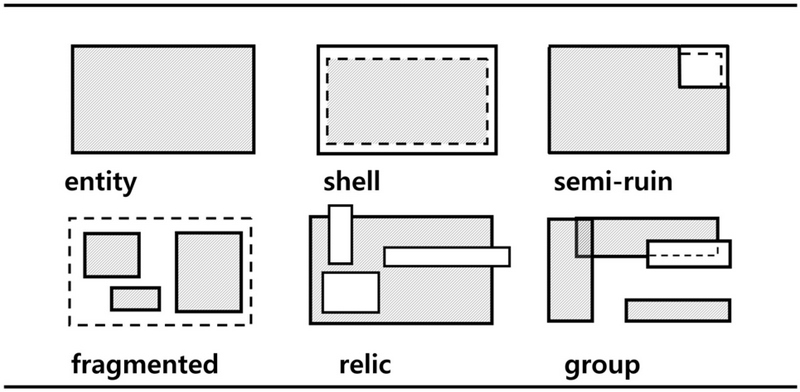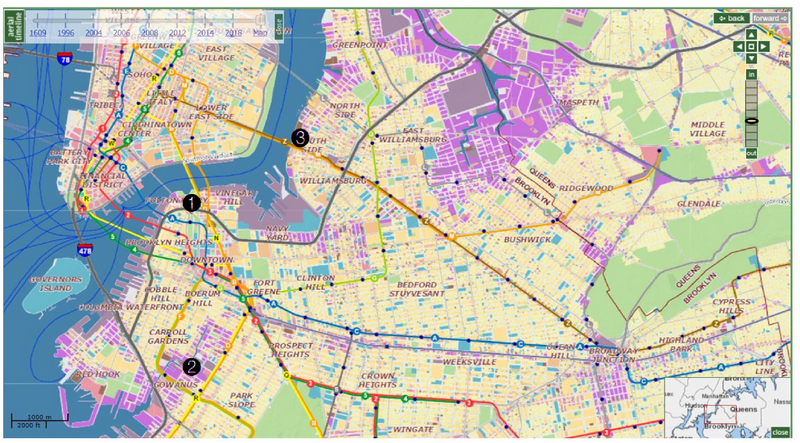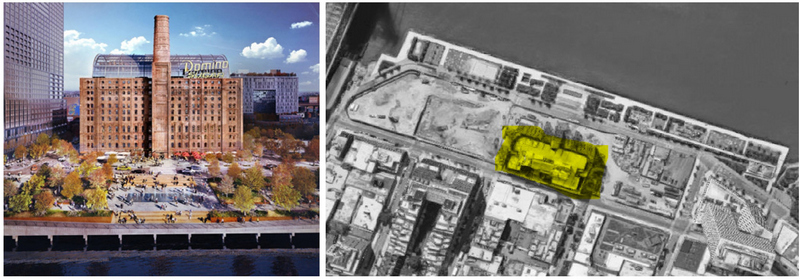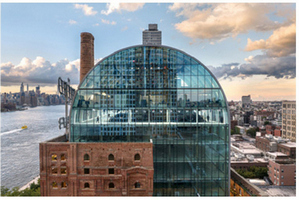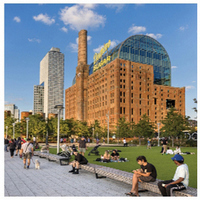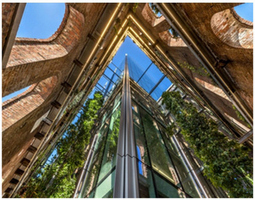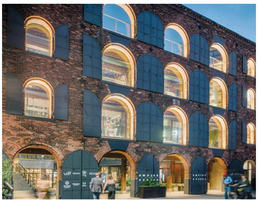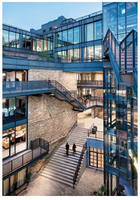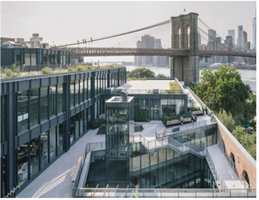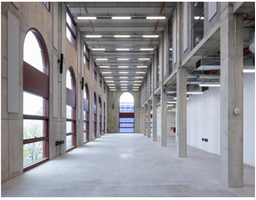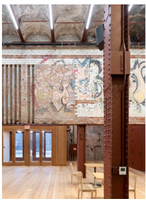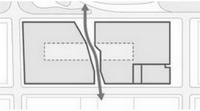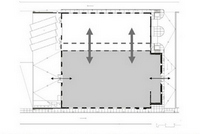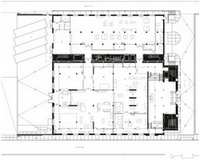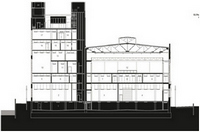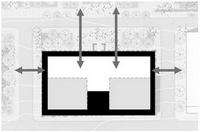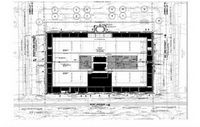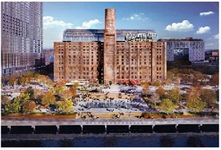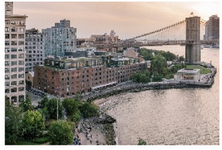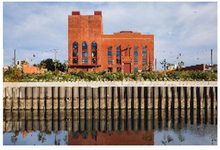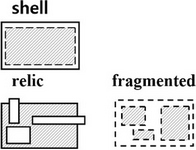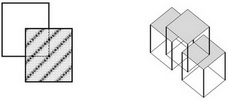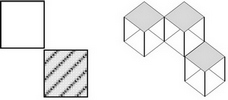
Architectural Narratives in Urban Fabric: Shaping Place Identity through Adaptive Reuse in Brooklyn
ⓒ 2024. KIEAE all rights reserved.
Abstract
This article aims to analyze the intricate process of repurposing industrial buildings within metropolitan landscapes, focusing on the design strategies that bridge old structures and new architecture. Three iconic cases in post-industrial areas of Brooklyn, New York, were selected. Through a detailed analysis of these repositioning projects, the article explores the design strategies employed to transform former upscale industrial buildings into vibrant, publicly accessible spaces.
The case study employs qualitative review methods to examine architectural transformations, emphasizing the significance of programs that foster community integration. A model was used to measure the relationship between existing spaces and the new volumes proposed in each project. This micro-level examination provides valuable insights for other metropolitan areas grappling with similar challenges, offering a blueprint for revitalizing post-industrial sites.
The research results show that the relationship between the façade of the original building and the new additions significantly impacts the design strategies employed. Furthermore, the integration of new programs connects not only to surrounding neighborhoods but also attracts city-scale visitors, creating a cultural hub that motivates social gatherings. These findings indicate that creative approaches to transforming the remaining parts of the buildings can embrace and enhance the place identity of the city. Additionally, existing theoretical classifications need to be updated to include additional categories of interventions for future designs, especially for historic buildings designated as landmarks.
Keywords:
Adaptive Reuse, Industrial Building, Repositioning, Place Identity, Urban Context1. Introduction
1.1. Study Objective
The primary focus of this study is to conduct a comprehensive analysis of the adaptive reuse of industrial buildings in the Metropolitan area, specifically within the neighborhoods of Brooklyn, New York. Positioned within the historical backdrop of industrialization and environmental complexities, set against an ever-evolving urban landscape, the study centers its attention on the transformative impact observed in renowned projects. The goal is to highlight the influence and extract lessons from the growth of the community in Brooklyn and Queens through reshaped place identity. The study’s development strategies spotlight creatively repurposing industrial structures and addressing architectural typology, human activities, and community impact. The adaptive reuse within these post-industrial areas, characterized by a dedication to both commercial and public planning, stands as evidence of the potential for urban revitalization and resilience. The insights gleaned from this analysis provide valuable direction for the broader Metropolitan area grappling with similar urban challenges, particularly in consideration of local demographics, economic shifts, and cultural dynamics [1, 2].
1.2. Method and Range of Study
The methodology employed for this study encompasses a multi-faceted approach:
1) Historical Exploration: This involves tracing the evolution of Brooklyn from an industrial center to its current state, assessing how historical factors have shaped its development needs and character.
2) Review of prior theory and process of Adaptive Reuse: This part examines recent trends in concept and theory of adaptive reuse of industrial buildings, analyzing responses to contemporary urban challenges and influential factors in city block development.
3) Repositioning Strategies: Delving into the strategic activation of building spaces and the re-identification of architecture with new programs. Especially how the transformation integrates urban context into the building and impact neighbor This utilizes insights from previous projects to propose design strategies aligned with evolving industry and cultural dynamics.
4) Case Studies: A detailed analysis of three iconic buildings contextualizes their offerings within the creative class narrative, assessing how design principles respond to both contemporary needs and the historical identity of the area.
2. Concept and Theory of Adaptive Reuse of Industrial Building
2.1. Adaptive Reuse in Metropolitan Area (Brooklyn)
The repositioning of industrial buildings within the Metropolitan area, particularly in Brooklyn, unfolds against the rich tapestry of New York City’s history, embodying a dual imperative rooted in both economic vitality and environmental stewardship. The redevelopment of three Brooklyn neighborhoods offers insights into various aspects of industrial area revitalization. The approach differs based on whether the developer and industrial facility owner are corporate, private, or governmental. Nonetheless, macro-level factors such as interest in post-industrial cities, the importance of waterfronts, and global economic trends are common considerations [5].
This interconnectedness between historical context, economic dynamics, and environmental considerations forms a nuanced backdrop for understanding the transformative impact of adaptive reuse in Brooklyn.
Throughout its history, New York City has undergone dynamic economic shifts, transitioning from its industrial heyday to the present era marked by innovation and technology. The adaptive reuse of industrial structures is a contemporary manifestation of the city’s ability to adapt and evolve. Iconic projects such as ‘Empire Stores,’ ‘Industry City,’ ‘Powerhouse Arts,’ and the ‘Domino Sugar Factory’ not only signify a departure from the city’s industrial past but also symbolize a strategic embrace of historical assets to fuel the present and future.
The trend of repurposing industrial spaces aligns with historical patterns of economic transformation in the city. New York has consistently reinvented itself, and these adaptive reuse projects become integral anchors driving economic growth. By preserving and revitalizing industrial structures, the city leverages its historical foundation to attract businesses, stimulate innovation, and foster job creation, echoing the resilient economic spirit that has characterized New York throughout its history [4].
In the context of the city’s history, the environmental imperative tied to industrial repositioning reflects a contemporary commitment to sustainability. As New York grapples with the challenges of urban development, the adaptive reuse trend emerges as an environmentally conscious response. By repurposing existing structures, these projects contribute to the conservation of the city’s historic character, reduce the ecological footprint associated with new construction, and champion a sustainable urban legacy [3].
In essence, the repositioning of industrial buildings in the Metropolitan area represents a nuanced interplay between historical continuity and forward-thinking strategies. Grounded in the city’s dynamic past, these projects forge a path toward a sustainable and economically vibrant future, weaving the threads of history into the fabric of a modern metropolis.
2.2. Post-industrial Sites & Landmarks in Brooklyn
The Brooklyn waterfront exemplifies the potential and trend of redeveloping post-industrial sites in urban areas. These areas, historically industrial hubs, are now being transformed into vibrant neighborhoods, attracting a diverse creative class. Landmark buildings within these neighborhoods serve as anchor projects, preserving historical elements while fostering economic and cultural revitalization.
It is essential to approach the regeneration design of waterfronts in an integrated manner, encompassing both urban spaces and programs. In New York’s waterfront parks, landmark buildings serve as new gateways for pedestrian connections, while facilities and event programs are seamlessly integrated into the waterfront [4].
Landmark buildings, such as those on the Brooklyn waterfront in Table 1., play a crucial role in these transformations. They maintain the historical spirit of the neighborhood while anchoring new developments. These projects illustrate how adaptive reuse can preserve historical landmarks, promote sustainability, and create new economic opportunities, setting a blueprint for future urban revitalization efforts.
The successful repositioning of industrial buildings as vibrant community anchors hinges on active public participation and the incorporation of local voices. Engaging community members in the planning and development process ensures that the projects not only meet economic and environmental goals but also resonate with the cultural and social dynamics of the neighborhood. By fostering a collaborative approach, these projects can address the needs and aspirations of local residents, thereby reinforcing place identity and strengthening the community's connection to its transformed urban landscape [5, 6].
3. Adaptive Reuse Process
The terminology and classification systems for adaptive reuse strategies may vary among researchers, but they often reflect similar underlying principles for integrating new elements into heritage buildings. The consistent aim across these strategies is to balance preserving historical significance with accommodating new uses.
This multi-dimensional approach ensures a thorough understanding of the transformative potential of adaptive reuse in urban settings, providing a blueprint for revitalizing post-industrial sites in other metropolitan areas. Such an analysis is crucial for promoting sustainable environments by utilizing existing building stock, thereby reducing the need for new construction and minimizing resource consumption [1].
Moreover, adaptive reuse ensures the conservation of cultural identity by preserving heritage buildings and giving them new life. This approach maintains the historical and architectural significance of these structures while integrating them into contemporary use, benefiting both the environment and the community [1].
The internal layout of reused buildings often transforms from their original industrial purposes, defined by the disposition of machines and the infrastructure required to support manufacturing processes. As industrial activities ceased, these infrastructures became available for new uses. Adaptive reuse initiates a second production of locality within the same spatial frame, fostering new patterns and uses. As Robiglio (2017) explains, physical spaces are integral to how individuals interact with and shape their environment, forming part of the production and object of that production [2].
In contemporary examples, ‘facadism’ has been used as a strategy to improve a building’s functionality, aesthetics, and urban performance [3].
However, adaptive reuse decisions must consider the unique barriers and opportunities of each building. While sustainability is increasingly important, economic outcomes often determine suitability for reuse. The success of adaptive optimization in linking a building’s commercial and operational performance to sustainability goals is influenced by various complex criteria, categorized under environmental, social, economic, and governance concepts [7].
The definition of design strategies for heritage buildings is a critical step in the adaptive reuse (AR) process. Literature reviews show that researchers use various terms to describe these strategies, which are essentially similar. While cultural-heritage values often dominate these lists, practical experiences of architects reveal that other factors also influence the selection of design strategies [8]. While cultural-heritage values are vital, the practical application of adaptive reuse strategies for heritage buildings requires a holistic approach that includes structural, economic, and contextual considerations.
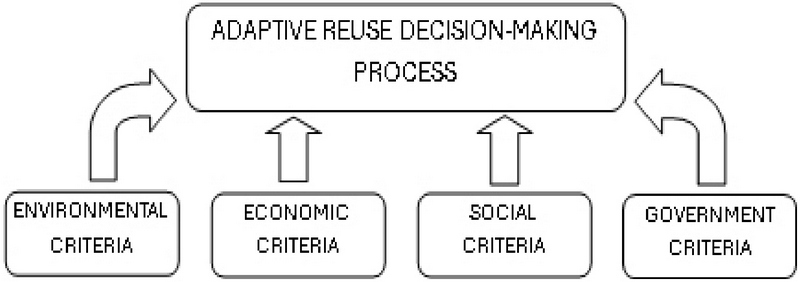
Architectural criteria of decision-making process for adaptive reuse(Source: redrawn by the author based on Liloiane Wong’s diagram)
In 1989, Robert identified seven strategies for adding new elements to existing buildings: integrating new structures within the existing ones, constructing over them, placing new elements alongside building around them, repurposing for a new function, designing in a similar style, and recycling materials from existing structures [9].

The procedure toward the definition of the sub-phases, the so-called “10 steps” of the adaptive reuse process of heritage buildings(Source: Fatemeh Hedieh Arfa, Hielkje Zijlstra, Barbara Lubelli, & Wido Quist, 2022)
In 2004, Brooker and Stone categorized these strategies using different terminology: insertion, intervention, and installation (Brooker & Stone, 2004). Other studies by Bloszies (2012), Cramer and Breitling (2007), and Plevoets and Van Cleempoel (2019) have discussed similar strategies with varying terminologies. While these researchers share common ideas about possible strategies, the differing terms can sometimes create confusion [10]. Table 2. demonstrate the extent of transformation of an existing building, including the three categories/strategies, four diagrams that illustrate the physical application, and a numeric scale that links the two measures [11].
The architects behind the transformation, recognized the spatial value and potential of the existing building, including its massive scale, rough finish, and robust structure. They utilized this potential to create a versatile space for hosting large-scale artworks, performances, and landscape installations. They employed a strategy of adding minimal architectural components, such as a ramp and platform, enhancing the space’s dynamic characteristics. The tactic of maintaining uniformity between the old and new elements, rather than creating a stark contrast, resulted in a cohesive, multi-layered environment that effectively supports contemporary art without overwhelming it. The case study on the Tate Modern competition, analyzed by Yoon-Jeoung Shin, illustrates the application of adaptive reuse strategies and tactics [12].
Host building serve as physical constructions into which new life is introduced. Their ability to sustain new uses depends on specific factors such as their condition, ability to sustain additional load, spatial fit with new demands, memory, and context. Fig. 3. shows how alterations and interventions can support the independent existence of host structures [6].
3.1. Existing Building Analysis
1) Code Compliance Check: Conducting a thorough review of building codes is essential to ensure that any change in use, especially when transitioning from manufacturing to office or retail, complies with local regulations. This process involves assessing zoning laws, occupancy requirements, and other relevant codes to avoid legal issues and ensure safety. Ensuring compliance with these codes helps maintain the integrity and safety of the building while accommodating its new purpose.
2) Structural and Fire Safety Check: Prioritizing structural and fire safety assessments is crucial to determine the building's capacity for new uses and ensure compliance with safety regulations. This involves evaluating load-bearing capacities, fire separation measures, and implementing necessary structural enhancements for safety. These assessments are fundamental in adapting the building to new functions while safeguarding occupants.
3) Accessibility Upgrade (Horizontal & Vertical): Improving accessibility both horizontally and vertically to meet modern standards is another key strategy. This may include installing ramps, elevators, or escalators to make spaces accessible to people with disabilities and meet current accessibility guidelines. Enhancing accessibility ensures that the building can be used by everyone, promoting inclusivity and compliance with contemporary accessibility standards.
3.2. Programing and Planning of the Building
Creating public and communal spaces within the building enhances community engagement and fosters a sense of connection. This strategy could involve incorporating common areas, meeting spaces, and shared amenities that contribute to a vibrant community atmosphere. These spaces not only provide residents and visitors with places to gather and interact but also strengthen the building’s role as a community hub.
Tailoring the adaptive reuse program to align with the city context, neighboring economy, and culture is crucial for its success. This strategy requires understanding the local demographic, economic trends, and cultural preferences to introduce programs that meet the community’s needs and enhance the area’s character. By aligning the building’s functions with its surroundings, it can effectively serve the community and integrate seamlessly into the urban fabric.
3.3. Adaptive Reuse Design Strategies & Classification
1) Re-configuring Interior Layout: The strategy involves reconfiguring the interior layout to accommodate the desired use and optimize space for functionality. This may include removing or adding partitions, adjusting room layouts, and incorporating modern design principles for efficiency and aesthetics. By reconfiguring the interior, the building can be made more suitable for contemporary needs while maintaining its historical essence.
2) Façade Analysis and Upgrade: Analyzing and upgrading the existing façade is another crucial strategy in adaptive reuse. This involves replacing or modifying windows, adding glass elements, or incorporating sustainable façade design to enhance the building’s visual appeal. Upgrading the façade not only improves the building’s aesthetics but also increases energy efficiency and openness, making it more inviting and environmentally friendly.
3) Utilizing Industrial Scale for Events: Leveraging the industrial scale of the building for hosting events, exhibitions, and special community engagements is an effective adaptive reuse strategy. This involves designing flexible spaces that can accommodate a variety of events, fostering community involvement, and promoting cultural activities. By utilizing the large, open spaces typical of industrial buildings, these structures can become vibrant centers for community interaction and cultural expression.
3.4. Identifying as a New Landmark
Cultural heritage includes buildings, artworks, architectural monuments, natural monuments, and areas with historical, aesthetic, and architectural significance. These heritage buildings are categorized based on their value—physical, environmental, social, and economic—and their types, such as archaeological, built, landscape, movable-collection, and conservation areas. Many cultural heritage buildings remain today, preserving the remarkable memories of society and history. Within this category, industrial heritage buildings hold both social and industrial historical values.
The concept of nostalgia can be used to explain the potential for reflecting the emotional resonance of particular places and structures through the reuse of existing buildings. Architects and designers have the opportunity to activate existing buildings as multi-layered structures. Through a deep understanding of the pre-existing elements, the remodeled building can be endowed with new and greater meaning [13].
When the historical value of industrial heritage sites is actively utilized as a visual element, the identity of the regenerated space can be intuitively expressed and effectively communicated. The historical value and architectural heritage of the space become design elements and the identity of the place itself, and these elements combine to form a brand [14].
By preserving historical elements and integrating them into contemporary contexts, adaptive reuse maintains a connection to the past while accommodating modern functionalities, enriching the narrative and character of the space. The classification of design strategies by Robert, Brooker, and Stone, along with other researchers, highlights the common principles underlying successful adaptive reuse projects. By enhancing place identity and creating new landmarks, these projects contribute to the cultural, economic, and social vitality of urban areas, honoring the past, serving the present, and inspiring the future.
Adaptive reuse of industrial heritage buildings is a powerful approach to preserving history while meeting modern needs, offering numerous benefits including cultural preservation, sustainability, economic revitalization, and community engagement. By employing thoughtful design strategies and respecting the historical integrity of these structures, adaptive reuse transforms industrial relics into vibrant, functional spaces that honor their past and serve contemporary society.
4. Case Study
For the case study, this paper uses the following selection criteria: The adaptive reuse project must involve historical landmarks located in the Brooklyn waterfront area of NYC, have a size exceeding 150,000 GSF, and have been completed and opened after 2015.
4.1. Domino Sugar Refinery
The Domino Sugar Refinery, a historic industrial site in Williamsburg, Brooklyn, is undergoing a profound transformation. Once responsible for processing 60% of America’s sugar, the refinery closed in the early 2000s, leading to a series of redevelopment plans. Initially proposed as luxury high-rises by the Community Preservation Corporation, the project faced community resistance and financial setbacks, leading to its acquisition by Two Trees Management.
Two Trees re-envisioned the site with a focus on adaptive reuse and community integration, diverging significantly from the earlier luxury development model. As shown on Table 3., the centerpiece of this redevelopment is the refinery building itself, now a landmark. Inside the preserved brick shell, a new 15-story glass structure stands, incorporating a rooftop garden and solar panels. The redevelopment plan includes public parks, affordable housing, and commercial spaces, aiming to create a balanced, sustainable urban environment. This project is an emblem of sustainable urban development, blending historical preservation with modern innovation. As the site evolves, including the iconic LED-lit “Domino Sugar” sign, it symbolizes a thoughtful integration of past and present, reshaping the place identity of Williamsburg’s waterfront.
Table 4. demonstrate the strategies and elements that was used for adaptive reuse, and continuity of urban context, by providing plaza and connection to the park brings significant impact to entire neighbor.
4.2. Empire Stores
Empire Stores, an iconic complex situated along the Brooklyn waterfront, serves as a compelling case study in the practice of adaptive reuse—a cornerstone of urban regeneration strategies. Initially erected during the 19th century to accommodate the storage and processing of coffee, the Empire Stores complex eventually fell into a state of disuse as the tide of industrialization receded.
However, the 21st century brought forth a transformative resurgence for this historically significant site. Diligent restoration efforts meticulously repurposed the aging warehouses, reimagining them as a vibrant nucleus for contemporary commerce and cultural engagement. Encompassing an expansive 390,000 square feet, Empire Stores has metamorphosed into a multifaceted complex housing a diverse array of retail outlets, gastronomic establishments, office spaces, and cultural venues.
What distinguishes this project is its meticulous juxtaposition of modern functionality and architectural innovation with an unwavering commitment to the preservation of the site's rich historical narrative. The enduring red-brick façade, bearing the indelible marks of its industrial heritage, has been carefully conserved. It now stands as both a visual testament to the past and a striking backdrop for contemporary activities.
Empire Stores has emerged as a thriving hub not only for commerce but also for culture and community. Local artisans and businesses have found a welcoming home within its storied walls, breathing new economic vitality into the surrounding neighborhood. Moreover, the complex’s well-curated public spaces have become venues for cultural events and exhibitions, contributing to the celebration of Brooklyn’s artistic spirit.
In conclusion, Empire Stores stands as an illustrious exemplar of adaptive reuse, epitomizing the reinvigoration of erstwhile industrial landmarks. By seamlessly blending historical preservation with modern functionality, it not only safeguards the rich heritage of the past but also invigorates the present and lays the groundwork for a dynamic and prosperous future. This case study underscores the potency of adaptive reuse as a catalyst for urban renewal, accentuating the interplay of history, culture, and commerce in the fabric of a revitalized urban landscape.
Table 6. shows different elements based on adaptive reuse strategies, and the continuity of urban context is very clear by creating relationship by new public courtyard and connecting pedestrian between Brooklyn bridge park and Dumbo area.
4.3. 461 Powerhouse Arts
Powerhouse Arts, nestled in Brooklyn’s Gowanus and Red Hook neighborhoods, represents a remarkable revitalization effort, breathing new life into an abandoned structure on a once-contaminated site. Spanning 170,000 square feet, this not-for-profit facility now stands as a thriving epicenter for artistic production and employment opportunities within the creative sector.
Initially constructed in 1904 as the Brooklyn Rapid Transit Power Station, the site’s historical significance faded over time, eventually earning the affectionate nickname “the Batcave” from local graffiti artists. However, the trajectory of this site shifted when the Gowanus Canal earned Superfund site status in 2010, marking it for remediation.
The heart of this redevelopment endeavor lies in the thoughtful reinterpretation of the historic Boiler House. This involves the careful restoration of its original mass and the re-establishment of its connection with the Turbine Hall. Crucially, this rejuvenated Boiler House has been strategically positioned on the site's original historic foundations, minimizing the need for extensive excavation.
The architectural transformation includes a concrete façade for the Boiler House that harmoniously complements the masonry shell of the Turbine Hall. This new envelope serves as a durable and straightforward addition, seamlessly blending with the existing structures. Notably, historic punched openings in the Turbine Hall have been ingeniously integrated into the design, now adorned with new windows.
Throughout this adaptive reuse project, a deep commitment to preservation, restoration, and reconstruction of essential elements from the original power station is evident. This includes the meticulous attention given to the masonry façade. By embracing these historical elements, the project accentuates the building's enduring industrial character while reinforcing its integration into the surrounding urban landscape.
In essence, Powerhouse Arts stands as a testament to the power of adaptive reuse. It not only breathes new life into an industrial relic but also honors its rich historical significance and industrial heritage. Through this transformative journey, a once-neglected structure has been reinvigorated to play a vital role in fostering artistic endeavors and community growth within Brooklyn’s creative landscape.
Table 8. is showing different architectural strategies and elements used for the alteration. The impact to the neighbor comes from not only the program but also how the host structure remain visually as landmark for representing the entire Gowanus Canel area among new residenial developments.
4.4. Summary and Discussion
In Chapter 4, we conducted an analysis of three distinct adaptive reuse projects in post-industrial sites within the Metropolitan area, guided by specific design strategy criteria. The chapter delves into four primary criteria: architectural elements, building recreation, and architectural experience.
Each project was evaluated on the implementation of these design strategies, with variations observed based on project size, scale, and programmatic considerations. The Domino Sugar Refinery project notably emphasizes public accessibility on its ground floor, in contrast to Domino Sugar Refinary, which is internally oriented towards building users. This distinction stems from each project’s unique urban context and adjacent public programs.
A crucial factor in successful revitalization is public access, which extends the memory and history of architecture. The redefinition of interior layouts based on use and program plays a significant role in this process.
The façade treatment is another critical strategy in establishing place identity. Each case study demonstrates a juxtaposition of old and new, either through new openings in the façade or by establishing a relationship between the new and existing building envelopes. This approach not only serves building users but also the public, offering an experiential understanding of the architectural envelope.
Industrial scale, a third factor, is rooted in the building’s original machinery and industrial functions. Contrasting human scale with this existing industrial scale evokes unique feelings and contributes to the place identity. This effect often arises from repeated structural elements, unexpected spatial volumes, and ceiling heights.
Finally, the continuity with city context and adjacent programs is a pivotal strategy in defining adaptive reuse projects. Community involvement and cultural productivity are impactful elements in these case studies. These projects serve as cultural creative hubs, ranging from community-scale services to urban landmarks, fostering transformative movements and city revitalization. Table 9. shows the importance of the urban continuity that visually and physically connecting inside out.

Architectural diagrams, floor plans, and section drawings identifying intervening & utilizing Industrial Shell
5. Conclusion
This paper has analyzed the intricate process of repurposing industrial buildings within metropolitan landscapes, focusing on design strategies that bridge old structures with new architecture. Through detailed case studies of three iconic adaptive reuse projects in post-industrial areas of Brooklyn, the research has highlighted the transformative potential of adaptive reuse in creating vibrant, publicly accessible spaces.
The analysis employed both quantitative and qualitative review methods to examine architectural transformations, emphasizing programs that foster community integration. A model was used to measure the relationship between existing spaces and new volumes, providing valuable insights for other metropolitan areas grappling with similar challenges.
Key findings indicate that the relationship between the original building façade and new additions significantly impacts the design strategies employed. The integration of new programs not only connects to surrounding neighborhoods but also attracts city-scale visitors, creating cultural hubs that motivate social gatherings. These findings underscore the importance of public access and the redefinition of interior layouts based on use and program in successful revitalization efforts.
The study further reveals that façade treatment is critical in establishing place identity, with each case study demonstrating a juxtaposition of old and new through new openings or relationships between the new and existing building envelopes. This approach enhances the architectural experience for both building users and the public, offering a tangible connection to the past.
The industrial scale, rooted in the building’s original machinery and functions, evokes unique feelings by contrasting human scale with existing industrial scale, contributing significantly to place identity. The continuity with city context and adjacent programs is also pivotal in defining adaptive reuse projects, with community involvement and cultural productivity being impactful elements.
Ultimately, adaptive reuse projects in Brooklyn serve as cultural creative hubs, fostering transformative movements and urban revitalization. By embracing and enhancing place identity through thoughtful design and strategic interventions, these projects honor the past, serve the present, and inspire the future. The research suggests that existing theoretical classifications need updating to include additional categories of interventions for future designs, particularly for historic buildings designated as landmarks. This study, with its focus on architectural design approaches, emphasizes the configuration and elements of buildings and offers a blueprint for revitalizing post-industrial sites, providing valuable guidance for metropolitan areas facing similar urban challenges. However, there are limitations in offering detailed insights and quantitative evaluations concerning the impact on users and the community. Therefore, further research is required, incorporating interviews with users, visitors, and the local community, to better understand the relationship with surrounding new buildings and the establishment of a sense of place.
References
-
D. Mısırlısoy, K. Günçe, Adaptive reuse strategies for heritage buildings: A holistic approach, Sustainable Cities and Society, 26, 2016.10, pp.91-98.
[https://doi.org/10.1016/j.scs.2016.05.017]

- M. Robiglio, RE-USA: 20 American stories of adaptive reuse: A toolkit for post-industrial cities, Germany: Jovis, 2017.
-
B. Plevoets, K. Van Cleempoel, Adaptive reuse of the built heritage: Concepts and cases of an emerging discipline, New York: Routledge, 2019.
[https://doi.org/10.4324/9781315161440]

- M.K. Kim, J.H. Lee, A study on the characteristics of design for renewal of New York Manhattan waterfront for downtown revitalization, Journal of the Architectural Institute of Korea Planning & Design, 25(4), 2009.04, pp.45-54.
-
J.B. Park, Redevelopment of Brooklyn’s industrial waterfronts: Navy Yard, Greenpoint, Red Hook, Korean Journal of Urban History, 34, 2023.11, pp.35-62.
[https://doi.org/10.22345/kjuh.2023.11.34.35]

-
L. Wong, Adaptive reuse: Extending the lives of buildings, Germany: Birkhäuser, 2017.
[https://doi.org/10.1515/9783038213130]

-
P.A. Bullen, P.E.D. Love, The rhetoric of adaptive reuse or reality of demolition: Views from the field, Cities, 27(4), 2010.08, pp.215-224.
[https://doi.org/10.1016/j.cities.2009.12.005]

-
F.H. Arfa et al., Adaptive reuse of heritage buildings: From a literature review to a model of practice, The historic environment: Policy & Practice, 13(2), 2022, pp.148-170.
[https://doi.org/10.1080/17567505.2022.2058551]

- P. Robert, Adaptations: New uses for old buildings, France: Editions du Moniteur, 1989.
- G. Brooker, S. Stone, Re-readings: Interior architecture and the design principles of remodelling existing buildings, London: RIBA Publishing, 2004.
- D. Fisher-Gewirtzman, Adaptive reuse architecture documentation and analysis, Journal of Architectural Engineering Technology, 5(3), 2016.09, 1000172.
-
Y.-J. Shin, The adaptive reuse design strategies - Focused on the case of the Tate Modern architectural competition, Journal of Asian Architecture and Building Engineering, 2024.01
[https://doi.org/10.1080/13467581.2023.2300387]

-
S. Stone, UnDoing buildings: Adaptive reuse and cultural memory, New York: Routledge, 2020.
[https://doi.org/10.4324/9781315397221]

- S. Ryu, Y. Hwang, J. Kim, A case study of industrial heritage regeneration space from the perspective of space branding, Journal of the Korea Institute of Spatial Design, 17(4), 2022.06, pp.85-97.
